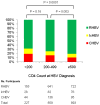The effect of human immunodeficiency virus on hepatitis B virus serologic status in co-infected adults
- PMID: 20084275
- PMCID: PMC2800198
- DOI: 10.1371/journal.pone.0008687
The effect of human immunodeficiency virus on hepatitis B virus serologic status in co-infected adults
Abstract
Background: Factors associated with serologic hepatitis B virus (HBV) outcomes in HIV-infected individuals remain incompletely understood, yet such knowledge may lead to improvements in the prevention and treatment of chronic HBV infection.
Methods and findings: HBV-HIV co-infected cohort participants were retrospectively analyzed. HBV serologic outcomes were classified as chronic, resolved, and isolated-HBcAb. Chronic HBV (CHBV) was defined as the presence of HBsAg on two or more occasions at least six months apart. Risk factors for HBV serologic outcome were assessed using logistic regression. Of 2037 participants with HBV infection, 281 (14%) had CHBV. Overall the proportions of HBV infections classified as CHBV were 11%, 16%, and 19% for CD4 cell count strata of > or =500, 200-499, and <200, respectively (p<0.0001). Risk of CHBV was increased for those with HBV infection occurring after HIV diagnosis (OR 2.62; 95% CI 1.78-3.85). This included the subset with CD4 count > or =500 cells/microL where 21% of those with HBV after HIV diagnosis had CHBV compared with 9% for all other cases of HBV infection in this stratum (p = 0.0004). Prior receipt of HAART was associated with improved HBV serologic outcome overall (p = 0.012), and specifically among those with HBV after HIV (p = 0.002). In those with HBV after HIV, HAART was associated with reduced risk of CHBV overall (OR 0.18; 95% CI 0.04-0.79); including reduced risk in the subsets with CD4 > or =350 cells/microL (p<0.001) and CD4 > or =500 cells/microL (p = 0.01) where no cases of CHBV were seen in those with a recent history of HAART use.
Conclusions: Clinical indicators of immunologic status in HIV-infected individuals, such as CD4 cell count, are associated with HBV serologic outcome. These data suggest that immunologic preservation through the increased use of HAART to improve functional anti-HBV immunity, whether by improved access to care or earlier initiation of therapy, would likely improve HBV infection outcomes in HIV-infected individuals.
Conflict of interest statement
Figures



Similar articles
-
Development of chronic hepatitis B virus infection in hepatitis B surface antigen negative HIV/HBV co-infected adults: a rare opportunistic illness.J Med Virol. 2011 Sep;83(9):1537-43. doi: 10.1002/jmv.22155. J Med Virol. 2011. PMID: 21739443
-
Evolution of hepatitis B serological markers in HIV-infected patients receiving highly active antiretroviral therapy.Clin Infect Dis. 2007 Nov 1;45(9):1221-9. doi: 10.1086/522173. Epub 2007 Sep 21. Clin Infect Dis. 2007. PMID: 17918088
-
Factors associated with elevated ALT in an international HIV/HBV co-infected cohort on long-term HAART.PLoS One. 2011;6(11):e26482. doi: 10.1371/journal.pone.0026482. Epub 2011 Nov 1. PLoS One. 2011. PMID: 22069454 Free PMC article.
-
Long-term serologic follow-up of isolated hepatitis B core antibody in HIV-infected and HIV-uninfected women.Clin Infect Dis. 2009 Jul 1;49(1):148-54. doi: 10.1086/599610. Clin Infect Dis. 2009. PMID: 19480573 Free PMC article.
-
Epidemiology and clinical management of HIV-HBV coinfected patients in a large AIDS Reference Center in Belgium.Acta Clin Belg. 2019 Dec;74(6):424-429. doi: 10.1080/17843286.2018.1554292. Epub 2018 Dec 4. Acta Clin Belg. 2019. PMID: 30513065
Cited by
-
Liver disease, HIV and aging.Sex Health. 2011 Dec;8(4):512-20. doi: 10.1071/SH10163. Sex Health. 2011. PMID: 22127037 Free PMC article. Review.
-
Hepatitis B vaccine antibody response and the risk of clinical AIDS or death.PLoS One. 2012;7(3):e33488. doi: 10.1371/journal.pone.0033488. Epub 2012 Mar 22. PLoS One. 2012. PMID: 22457767 Free PMC article.
-
Strategies to increase responsiveness to hepatitis B vaccination in adults with HIV-1.Lancet Infect Dis. 2012 Dec;12(12):966-76. doi: 10.1016/S1473-3099(12)70243-8. Lancet Infect Dis. 2012. PMID: 23174382 Free PMC article. Review.
-
Hepatitis B virus coinfection negatively impacts HIV outcomes in HIV seroconverters.J Infect Dis. 2012 Jan 15;205(2):185-93. doi: 10.1093/infdis/jir720. Epub 2011 Dec 5. J Infect Dis. 2012. PMID: 22147794 Free PMC article.
-
The timing of hepatitis B virus (HBV) immunization relative to human immunodeficiency virus (HIV) diagnosis and the risk of HBV infection following HIV diagnosis.Am J Epidemiol. 2011 Jan 1;173(1):84-93. doi: 10.1093/aje/kwq326. Epub 2010 Nov 4. Am J Epidemiol. 2011. PMID: 21051446 Free PMC article.
References
-
- Thio CL, Seaberg EC, Skolasky R, Phair J, Visscher B, et al. HIV-1, hepatitis B virus, and risk of liver-related mortality in the Multicenter Cohort Study (MACS). Lancet. 2002;360:1921–1926. - PubMed
-
- Soriano V, Puoti M, Peters M, Benhamou Y, Sulkowski M, et al. Care of HIV patients with chronic hepatitis B: updated recommendations from the HIV-hepatitis B virus international panel. AIDS. 2008;22:1399–1410. - PubMed
-
- Tedaldi E, Peters L, Neuhaus J, Puoti M, Rockstroh J, et al. Opportunistic disease and mortality in patients coinfected with hepatitis B or C virus in the strategic management of antiretroviral therapy (SMART) study. Clinical Infectious Diseases. 2008;47:1468–1475. - PubMed
-
- Chun HM, Landrum ML. Liver-related complications in HIV-infected individuals. Infect Dis Clin Practice. 2007;15:38–48.
-
- Sulkowski MS. Management of hepatitic complications in HIV-infected persons. Journal of Infectious Diseases. 2008;197:s279–293. - PubMed
Publication types
MeSH terms
Grants and funding
LinkOut - more resources
Full Text Sources
Medical
Research Materials

